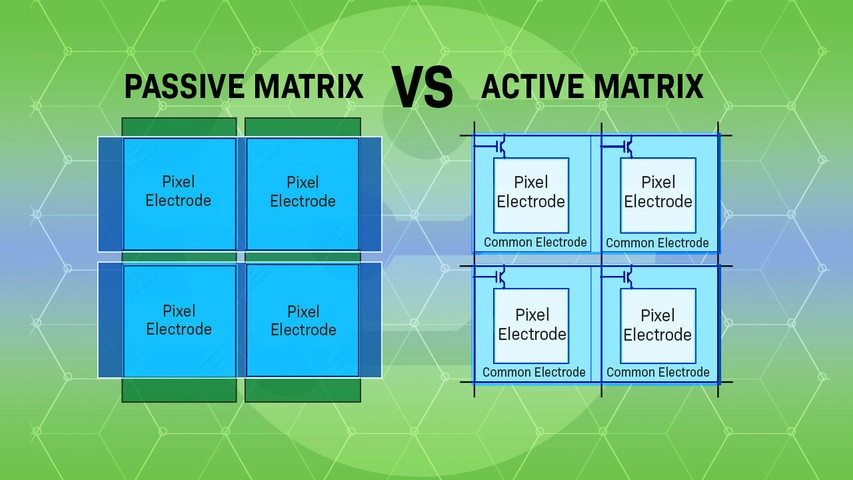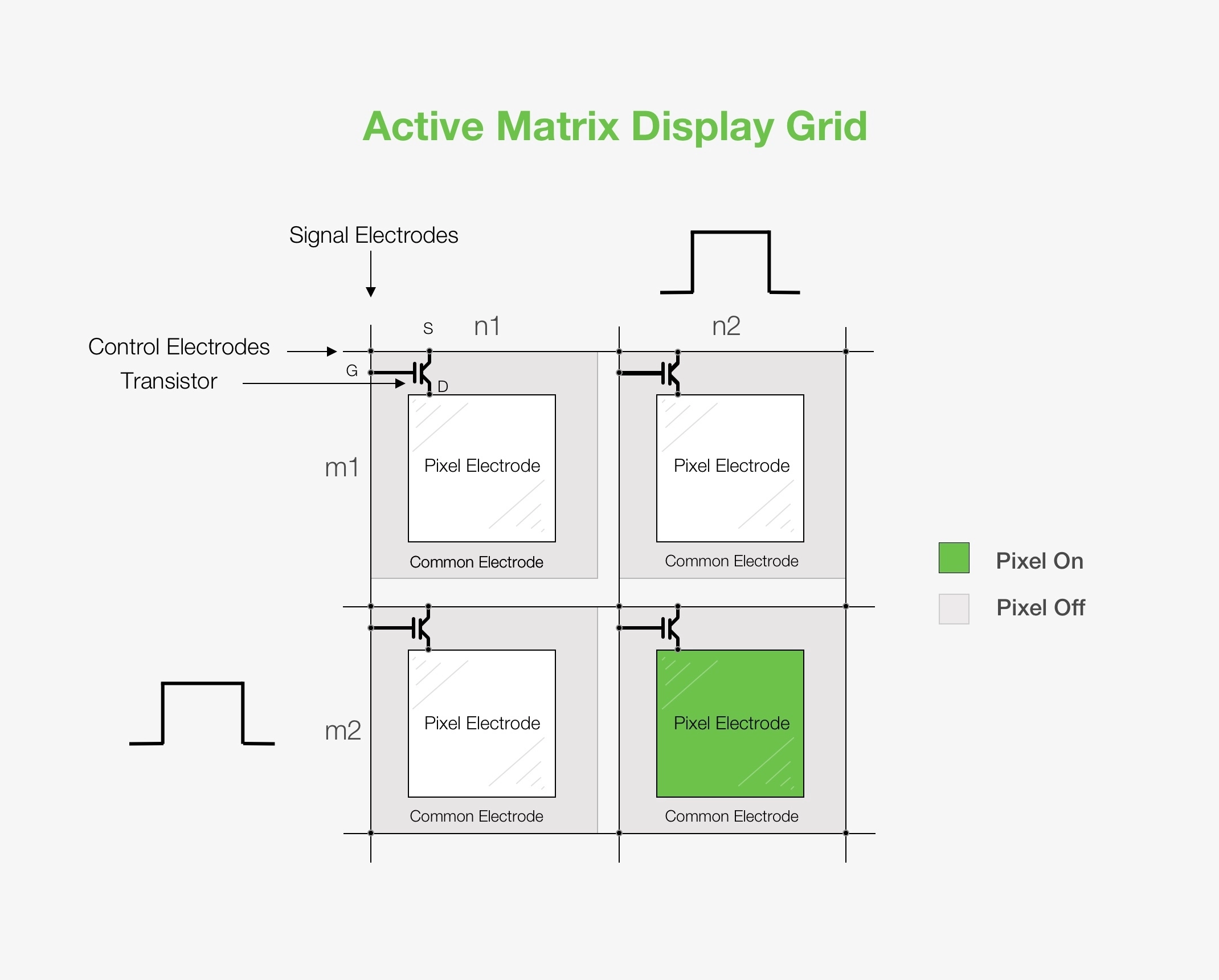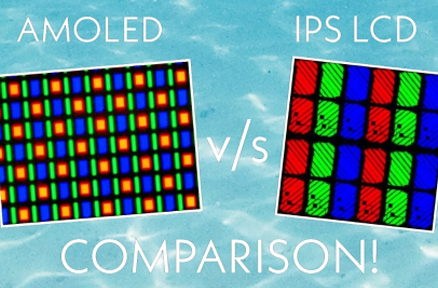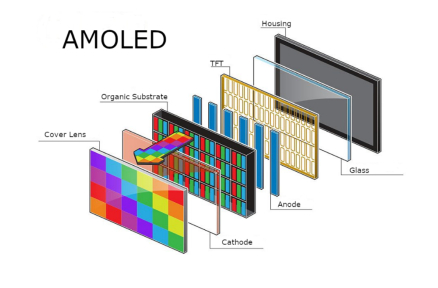Display technologies form the backbone of modern electronics, enabling everything from industrial control panels to medical imaging devices. At the heart of these systems lies pixel addressing, a process that determines how images are rendered on screens. Two primary methods dominate this space: passive matrix and active matrix technologies. Understanding these approaches is essential for manufacturers and suppliers selecting components for reliable, high-performance applications.
Both LCD and OLEDs leverage matrix structures, categorized as passive matrix LCDs/OLEDs (PMOLED) or active matrix variants (AMOLED for OLEDs, TFT for LCDs). This guide explores matrix displays, their operational principles, and a detailed comparison to aid informed decision-making in display integration projects.

What Are Matrix Displays?
Matrix displays consist of a grid-based arrangement of pixels, the fundamental light-emitting or light-modulating elements that construct visual content. These pixels are organized in rows and columns, allowing precise control to form text, graphics, or dynamic videos. Such displays power a wide array of devices, including high-resolution industrial monitors, medical diagnostic screens, and embedded systems in automation equipment.
LCDs and OLEDs both employ matrix technology for pixel management. In LCDs, liquid crystals twist to control backlight passage, while OLEDs emit light organically upon electrical stimulation. The matrix framework ensures efficient addressing, where multiplexing activates specific rows and columns to illuminate targeted pixels. This differentiation—passive versus active—impacts resolution, refresh rates, and overall suitability for demanding environments like manufacturing floors or healthcare facilities.
How Matrix Displays Work
Images emerge from selectively energizing pixels within the row-column grid. Multiplexing scans the array sequentially: a row activates, followed by column signals dictating pixel states. This rapid cycling refreshes the entire display multiple times per second, creating the illusion of continuous motion.
Passive systems rely on direct electrode intersections for control, simplifying hardware but introducing limitations in precision. Active setups incorporate switching elements per pixel, enhancing stability and speed. For industrial suppliers, grasping these mechanics supports optimal selection of TFT LCD modules, such as those from Shenzhen-based manufacturers specializing in rugged, customized solutions.
Passive Matrix Displays
Passive matrix displays represent an earlier, streamlined approach to pixel control, utilizing a network of row and column electrodes without dedicated switching components per pixel. Voltage application at intersections activates pixels, altering their optical behavior to produce light or modulate transmission.
Structure of Passive Matrix Displays
The architecture emphasizes minimalism, featuring:
-
Row Electrodes: Horizontal conductors linking all pixels in a row, distributing activation signals uniformly.
-
Column Electrodes: Vertical lines connecting column pixels, enabling targeted voltage delivery.
-
Pixel Electrodes: Intersection points where applied voltage governs pixel attributes like brightness and color. In LCD configurations, electric fields reorient liquid crystals to regulate backlight; in OLEDs, direct current triggers emission.
This electrode-only design reduces complexity, making passive matrices cost-effective for basic implementations. However, crosstalk—unintended activation of adjacent pixels—can occur due to shared lines.
How Passive Matrix Displays Work
Operation hinges on grid-based addressing with m row lines and n column lines, totaling m+n controls. “Passive” denotes the absence of active elements; pixels respond via inherent thresholds to voltage differentials.
To illuminate a pixel, simultaneous row and column selection creates a voltage drop (V_on for activation, V_off for deactivation). In LCDs, this twists crystals to permit or block light; in OLEDs, it excites emitters proportionally. Constant refreshing prevents fading, as pixels lack charge retention.
For suppliers integrating into low-power devices, this method suits static content well, though dynamic scenarios reveal refresh delays.
Passive Matrix Advantages
-
Affordable Production: Fewer components lower manufacturing costs, ideal for volume orders in entry-level industrial tools.
-
Lower Power Consumption for Static Images: No continuous transistor draw conserves energy in unchanging displays, beneficial for battery-operated medical portables.
-
Simplicity in Basic Applications: Straightforward design facilitates quick prototyping for non-demanding resolutions.
Passive Matrix Disadvantages
-
Slower Response Time: Sequential scanning induces ghosting in motion-heavy content, limiting use in fast-paced monitoring systems.
-
Limited Viewing Angles: Electrode control yields narrow optimal views, degrading off-axis contrast—unsuitable for collaborative medical reviews.
-
Lower Contrast Ratios: Grayscale shifts reduce depth, with blacks appearing washed out under ambient light.
Passive Matrix Applications
These displays excel in cost-sensitive, low-resolution scenarios: digital gauges in factory automation, e-paper mimics for inventory trackers, or simple medical thermometers. Suppliers like Display Kadi offer passive variants for such integrations, ensuring reliability in constrained budgets.
Active Matrix Displays

Active matrix displays advance pixel management through individual control elements, primarily Thin Film Transistors (TFTs). Each pixel pairs with a transistor, enabling independent addressing for superior fidelity and responsiveness.
Structure of Active Matrix Displays
Key elements include:
-
Signal Electrodes: Column lines delivering image data voltages to transistors.
-
Control Electrodes: Row lines gating transistor activation.
-
Thin Film Transistor (TFT): Per-pixel switch with source, drain, and gate terminals; gate voltage toggles conductivity, charging pixel capacitors.
-
Common Electrode: Grounded shared plane forming fields with pixel electrodes.
-
Pixel Electrode: Unique per pixel, sustaining charge for light modulation.
TFT layers deposit thinly on glass substrates, integrating seamlessly with LCD or OLED matrices.
How Active Matrix Displays Work
Transistor-capacitor pairs store pixel states post-refresh. Sequential row selection activates gates, allowing column signals to charge capacitors. Held charges persist, minimizing crosstalk and enabling high refresh rates.
This sustains uniform illumination across frames, critical for flicker-free industrial visuals. In TFT LCDs, fields twist crystals; in AMOLED, they drive organic emitters.
Active Matrix Advantages
-
Superior Image Quality: Persistent states yield high contrast and sharpness, vital for precise medical imaging.
-
Fast Response Times: Pixel independence eradicates motion blur, supporting real-time data in manufacturing dashboards.
-
Wide Viewing Angles: Uniform control preserves colors and brightness from varied perspectives, enhancing usability in team-oriented setups.
Active Matrix Disadvantages
-
Higher Manufacturing Costs: Transistor fabrication elevates complexity and price, though scalable for bulk supplier orders.
-
Elevated Power Use: Continuous control draws more energy, offset by efficiency gains in dynamic operation.
Active Matrix Applications
Dominating premium sectors, active matrices power high-end industrial HMI panels, surgical displays, and automotive interfaces. Manufacturers favor TFT variants for their robustness in harsh conditions.
Passive vs Active Matrix
Both technologies grid pixels for addressing, yet diverge in control finesse. Passive matrices employ electrode meshes for economy, trading responsiveness for affordability—suited to static, budget-driven industrial gauges. Active matrices deploy transistors for precision, delivering vibrant, stable visuals at higher costs, ideal for dynamic medical and automation screens.
In practice, passive suits resolutions below 320×240 with refresh rates under 60Hz; active excels beyond, supporting 4K and 120Hz+. Power profiles flip: passive conserves in idles, active in motion. Viewing and contrast favor active, with IPS enhancements broadening angles to 178°.
For B2B decisions, active matrices align with evolving standards in reliability-focused sectors, as evidenced by ISO-certified suppliers prioritizing TFT for longevity.
Conclusione
Passive and active matrix displays each carve niches in the display ecosystem, balancing cost, performance, and application needs. Passive options streamline basic integrations, while active—particularly TFT LCDs—elevates quality for sophisticated demands. Selecting based on resolution, environment, and budget ensures optimal outcomes in industrial and medical projects.
As display tech evolves, hybrid innovations promise to bridge gaps, but core principles endure. Manufacturers and engineers benefit from partnering with experienced suppliers versed in these foundations.
Domande frequenti
What is the main difference between passive and active matrix displays?
Passive matrix displays use a simple grid of electrodes for pixel control, making them cost-effective but prone to slower responses and crosstalk. Active matrix displays incorporate transistors like TFTs for individual pixel addressing, resulting in sharper images, faster refresh rates, and better viewing angles.
Which matrix technology is better for industrial applications?
Active matrix, especially TFT LCDs, is preferred for industrial settings due to its superior contrast, response times, and durability in high-vibration environments. Passive matrices work for low-cost, static displays like basic sensors.
How do passive matrix displays handle motion compared to active ones?
Passive matrices often exhibit ghosting from sequential scanning, unsuitable for fast-motion content. Active matrices maintain pixel states via capacitors, eliminating blur for smooth video in monitoring systems.
Are passive matrix displays still used in modern devices?
Yes, in budget-conscious applications like calculators, e-readers, and simple medical devices where high resolution isn’t required.
What role do certifications play in choosing matrix display suppliers?
Certifications like ISO9001, ISO13485, and IATF16949 ensure quality, reliability, and compliance, crucial for industrial and medical displays to meet regulatory standards.
Looking for display Manufacturers and Suppliers? Partner with Kadi Display for Premium TFT LCD and AMOLED Solutions
As a leading manufacturer and supplier of high-quality TFT LCD and AMOLED displays, Kadi Display delivers tailored active matrix solutions for industrial and medical applications.
Elevate project performance—contact our team at Sales@sz-kadi.com or +86-13662585086 to request a quote, explore prototyping, or discuss bonding options like optical clear adhesive for rugged durability. Secure reliable displays that drive efficiency and innovation today.
Ultimi Blog & Notizie
- Passive Matrix vs Active Matrix - A Beginner's Guide
- Which Display for Raspberry Pi Interface Optimizes Touch Control: DSI MIPI or HDMI?
- Power of Industrial TFT LCD Touch Screen: Revolutionizing Interactivity
- Qual è la differenza tra anti-riflessione e anti-abbagliamento?
- I parametri importanti dello schermo TFT
Blog & Notizie correlate
-
TN contro IPS2024-7-9
-
TN contro IPS2024-7-9









